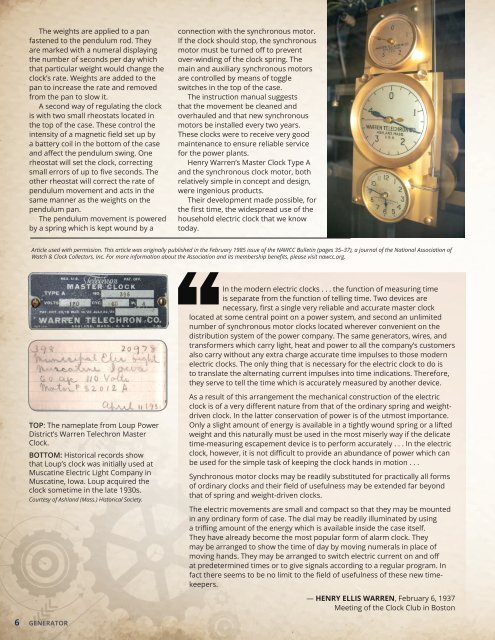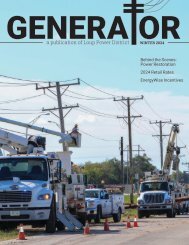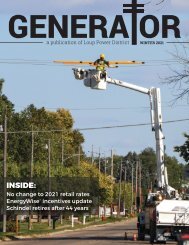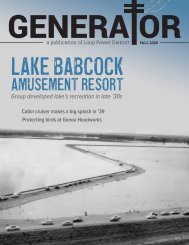Loup Generator - Summer2019
This issue of the Loup Power District Generator includes updates on repairs at the the Genoa Headworks, a story about the Telechron Master Clock, employee anniversaries, and more.
This issue of the Loup Power District Generator includes updates on repairs at the the Genoa Headworks, a story about the Telechron Master Clock, employee anniversaries, and more.
You also want an ePaper? Increase the reach of your titles
YUMPU automatically turns print PDFs into web optimized ePapers that Google loves.
The weights are applied to a pan<br />
fastened to the pendulum rod. They<br />
are marked with a numeral displaying<br />
the number of seconds per day which<br />
that particular weight would change the<br />
clock’s rate. Weights are added to the<br />
pan to increase the rate and removed<br />
from the pan to slow it.<br />
A second way of regulating the clock<br />
is with two small rheostats located in<br />
the top of the case. These control the<br />
intensity of a magnetic field set up by<br />
a battery coil in the bottom of the case<br />
and affect the pendulum swing. One<br />
rheostat will set the clock, correcting<br />
small errors of up to five seconds. The<br />
other rheostat will correct the rate of<br />
pendulum movement and acts in the<br />
same manner as the weights on the<br />
pendulum pan.<br />
The pendulum movement is powered<br />
by a spring which is kept wound by a<br />
connection with the synchronous motor.<br />
If the clock should stop, the synchronous<br />
motor must be turned off to prevent<br />
over-winding of the clock spring. The<br />
main and auxiliary synchronous motors<br />
are controlled by means of toggle<br />
switches in the top of the case.<br />
The instruction manual suggests<br />
that the movement be cleaned and<br />
overhauled and that new synchronous<br />
motors be installed every two years.<br />
These clocks were to receive very good<br />
maintenance to ensure reliable service<br />
for the power plants.<br />
Henry Warren’s Master Clock Type A<br />
and the synchronous clock motor, both<br />
relatively simple in concept and design,<br />
were ingenious products.<br />
Their development made possible, for<br />
the first time, the widespread use of the<br />
household electric clock that we know<br />
today.<br />
Article used with permission. This article was originally published in the February 1985 issue of the NAWCC Bulletin (pages 35–37), a journal of the National Association of<br />
Watch & Clock Collectors, Inc. For more information about the Association and its membership benefits, please visit nawcc.org.<br />
“<br />
In the modern electric clocks . . . the function of measuring time<br />
is separate from the function of telling time. Two devices are<br />
necessary, first a single very reliable and accurate master clock<br />
located at some central point on a power system, and second an unlimited<br />
number of synchronous motor clocks located wherever convenient on the<br />
distribution system of the power company. The same generators, wires, and<br />
transformers which carry light, heat and power to all the company’s customers<br />
also carry without any extra charge accurate time impulses to those modern<br />
electric clocks. The only thing that is necessary for the electric clock to do is<br />
to translate the alternating current impulses into time indications. Therefore,<br />
they serve to tell the time which is accurately measured by another device.<br />
TOP: The nameplate from <strong>Loup</strong> Power<br />
District’s Warren Telechron Master<br />
Clock.<br />
BOTTOM: Historical records show<br />
that <strong>Loup</strong>’s clock was initially used at<br />
Muscatine Electric Light Company in<br />
Muscatine, Iowa. <strong>Loup</strong> acquired the<br />
clock sometime in the late 1930s.<br />
Courtesy of Ashland (Mass.) Historical Society.<br />
6 GENERATOR<br />
As a result of this arrangement the mechanical construction of the electric<br />
clock is of a very different nature from that of the ordinary spring and weightdriven<br />
clock. In the latter conservation of power is of the utmost importance.<br />
Only a slight amount of energy is available in a tightly wound spring or a lifted<br />
weight and this naturally must be used in the most miserly way if the delicate<br />
time-measuring escapement device is to perform accurately . . . In the electric<br />
clock, however, it is not difficult to provide an abundance of power which can<br />
be used for the simple task of keeping the clock hands in motion . . .<br />
Synchronous motor clocks may be readily substituted for practically all forms<br />
of ordinary clocks and their field of usefulness may be extended far beyond<br />
that of spring and weight-driven clocks.<br />
The electric movements are small and compact so that they may be mounted<br />
in any ordinary form of case. The dial may be readily illuminated by using<br />
a trifling amount of the energy which is available inside the case itself.<br />
They have already become the most popular form of alarm clock. They<br />
may be arranged to show the time of day by moving numerals in place of<br />
moving hands. They may be arranged to switch electric current on and off<br />
at predetermined times or to give signals according to a regular program. In<br />
fact there seems to be no limit to the field of usefulness of these new timekeepers.<br />
— HENRY ELLIS WARREN, February 6, 1937<br />
Meeting of the Clock Club in Boston

















